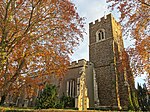South West Bedfordshire (UK Parliament constituency)
Constituencies of the Parliament of the United Kingdom established in 1983Parliamentary constituencies in Bedfordshire

South West Bedfordshire is a constituency represented in the House of Commons of the UK Parliament. As with all constituencies of the UK Parliament, it elects one Member of Parliament (MP) by the first past the post system of election. The serving Member since 2001 is Conservative Andrew Selous, who succeeded Conservative David Madel. Selous has been re-elected five times: in 2005, 2010, 2015, 2017 and 2019. Under the 2023 Periodic Review of Westminster constituencies, the constituency will only be subject to minor boundary changes, but is to be renamed Dunstable and Leighton Buzzard - to be first contested at the next general election.
Excerpt from the Wikipedia article South West Bedfordshire (UK Parliament constituency) (License: CC BY-SA 3.0, Authors, Images).South West Bedfordshire (UK Parliament constituency)
Pilgrims Close,
Geographical coordinates (GPS) Address Nearby Places Show on map
Geographical coordinates (GPS)
| Latitude | Longitude |
|---|---|
| N 51.958 ° | E -0.491 ° |
Address
Pilgrims Close
Pilgrims Close
LU5 6LY
England, United Kingdom
Open on Google Maps









